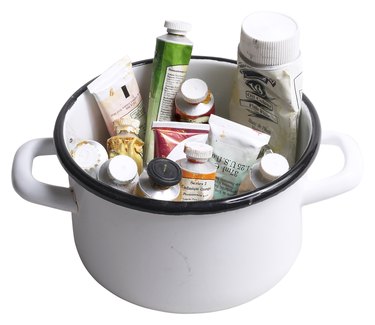Things You'll Need
Drawing materials
Reference pictures
Stretched canvas
Watercolor paper
Gesso
Water
Sandpaper
Artist's paintbrushes
Acrylic paints

Fish make visually interesting subjects for acrylic paintings with their bright, iridescent colors and streamlined, dynamic forms. Fish are painted in highly detailed, anatomically correct pictures, or are stylized and abstracted. Either way, compositions featuring fish have a long history. Acrylic paint can be used straight from the tube or thinned out, like watercolor, to depict fish. The water-dwelling animals can be painted in groups or alone. They can be worked into a watery landscape, or shown with a neutral background in the style of the Chinese and Japanese master artists.
Step 1
Practice drawing fish to paint them convincingly in acrylics. Observe fish in aquariums or use reference photos from books and the Internet. Study and sketch the fish when they're at rest and while moving. Start drawing them by outlining their basic form. Keep the fish in proper proportion. Learn to correctly place the fins and realistically draw details such as the facial features and scale patterns. Make thumbnail sketches of details of the overall fish compositon including aquatic plants and light reflections in the water.
Video of the Day
Step 2
Prepare a canvas on wooden stretchers for the painting's support. Use heavyweight watercolor paper for acrylics thinned to the consistency of watercolor paint. Prime the canvas with acrylic gesso. Brush it on in successively thinner coats. Add a little more water to each coat. Sand the surface smooth between each coat. Draw the fish composition directly on to the canvas with pencil or use a sharply pointed, small round brush and water-thinned paint.
Step 3
Choose acrylic colors to match the natural coloration of the fish. Brush on a light coat of clear water. Thin the acrylic colors with water. Lay in the preliminary washes of color. Block in the basic forms of the fish and its surroundings. Use a graduated wash for the background, varying the tones from darker to lighter as you paint. Use color-graded washes for the fish body. Drop different hues of paint into the washes for a wet-in-wet effect.
Step 4
Establish a light source for the painting and use it to place shadows and shade the fish. Express the three-dimensional qualities of the fish with subsequent coats of paint. Establish the tonal structure of the picture with transparent or translucent washes of color. Set up a relationship between the positive space of the fish in the foreground and the negative background space of the water.
Step 5
Exploit the opaque nature of acrylics to fill in the details of the fish. Describe and define the coutours of the fish's belly, tail and head with smooth, controlled brush strokes. Use a small, round detail brush with flexible bristles to finish the detail work. Paint the lines and shadows in the fins. Refine the textures and patterns of the fish's scales. Suggest light reflecting off the shiny scales. Finish up by adding the highlights, such as the tiny catch-lights in the fish's eyes.
Tip
Add modeling medium to acrylic paint for increased texture. Mix glazing paste with the paint for added luminosity of colors.
Warning
Don't overwork the picture by including too much detail. Keep the painting simple and to the point.
Video of the Day